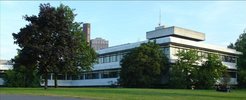
Bonn: Center of Excellence in Astronomy since 1845
Bonn is one of the astronomy centers of excellence in Germany with a long standing tradition for leading research and advanced teaching in astronomy.

Since 1836, when Friedrich Wilhelm August Argelander became director of the observatory at the University of Bonn astronomy developed quickly. He erected the Sternwarte (Institute for Optical Astronomy) at the Poppelsdorfer Allee, which started operation in 1845. The results of his observations appear in the Bonner Durchmusterung (Bonn astrometric survey, 1862), which records the positions and brightness of more than 324,000 stars (up to the ninth magnitude) in the northern skies.
The vicinity of Cologne, a metropolitan city with international character, hosting the largest University in Germany, complements the research landscape which serves as a framework for the IMPRS for Astronomy and Astrophysics.
The Argelander-Institut für Astronomie of the University of Bonn
Actual research covers a wide range of astronomical phenomena. The access to new wavelength domains and measurements in space lead to the foundation of further research institutes in Bonn, so the Radioastronomisches Institut - Institute for Radio Astronomy [RAIUB] in 1962, the Institut für Astrophysik und Extraterrestrische Physik - Institute for Astrophysics and Space Science [IAEF] in 1964 and the Max-Planck-Institut für Radioastronomie - Max Planck Institute for Radio Astronomy [MPIfR] in 1966. The university institutes merged into the Argelander Institute for Astronomy (AIfA) in 2005.
Since 1973 all institutes are located in the same building, which leads to close collaboration.
1st Physics Institute of the University of Cologne

The 1st Physics Institute of the University of Cologne devotes its research to the field of astrophysics, including projects such as the Heterodyne Instrument for Far Infrared astronomy (HIFI) for the HERSCHEL space observatory, the Cologne Database for Molecular Spectroscopy (CDMS), the Near-Infrared Interferometric Camera for the Large Binocular Telescope, the Mid-Infrared imager and spectrograph (MIDI) for the James Webb Space Telescope, the Stratospheric Observatory for Infrared Astronomy, the NANTEN2 submillimetre telescope at the Atacama desert in Chile, the KOSMA 3-m telescope on Gornergrat for observations in the submillimetre and THz band, and the Oh-Supressing Infra-Red Imaging Spectograph (OSIRIS) for the Keck Observatory.
Among the faculty members, the research topics of the workgroup of Prof. Eckart are linked to the field of stellar and gas dynamics in external host galaxies and astrophysical disks in general, the analysis of the stellar populations in the central regions of galaxies, as well as their interaction with the central massive black hole. Interferometric methods from the cm- via the mm- to the mid-infrared and near-infrared domain are being employed.
The following hardware projects are part of the group’s effort:
- The LBT beam combiner LINC/NIRVANA
- The low resolution double prism for the James Webb Space Telescope MIRI imager
- Active support of the VLTI by the provision of the 4th VLTI star separator unit
- The spectrometer/camera for the VLTI 2nd generation instrument GRAVITY
Joint Research
The Max-Planck-Institut für Radioastronomie (MPIfR) and the partner university institutes are actively involved in technical developments for the current and the next generation of optical and radio telescopes: Very Long Baseline Interferometry, large single dish telescopes in the cm and mm regime (100-m Effelsberg, 30-m Pico Veleta), as well as submm-telescopes and interferometers (Plateau de Bure, APEX, and ALMA), and optical interferometry (VLTI) or LBT.

